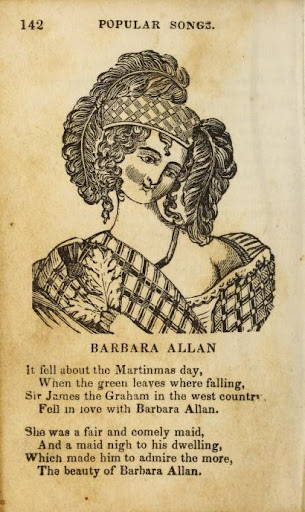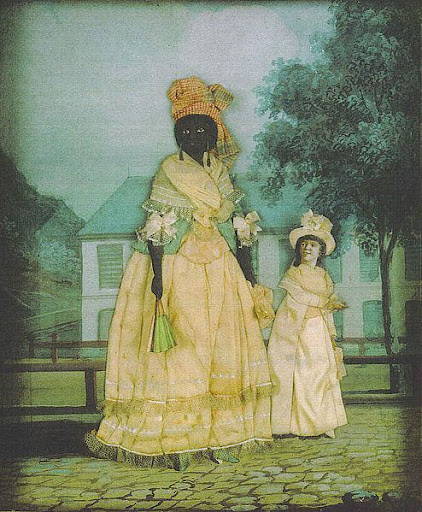Adelaide Magnolia Letter 6 – British Folk Songs
British Folk Songs

Scan of “Barbara Allan” pg. 142 from Forget Me Not Songster, 1840. New York: Nafis & Cornish. Courtesy Internet Archive.
A tavern song, sea shanty, work song, war song, love ballad, or lullaby, are all examples of folk songs. Folk songs were passed down from generation to generation orally, told a story, and got their name because they were created by ordinary people or folk, not the renowned and educated composers and musicians of the time. Historical records show British folk music was around as early as the arrival of the Anglo-Saxons in the 5th century, and it is still around today.
Folk songs may not have been the classical or “proper” music of the time, but the popularity of it had been rising for some time. By nature, a folk song being an oral tradition, it would take time for popularity to spread. But with the invention of the printing press and increasing use of print materials in the 16th and 17th centuries, collections of folk songs were being produced, making them available to all classes of society, not just the “folk.” And in the 18th century, with the romantic movement and the rise in the popularity of poetry, there were many ballads written and sung. By the early 19th century, folk music was popular and widespread and was sung and danced to in taverns and ballrooms and everywhere in between.
The French Quarter and Quadroon Balls
The French Quarter today is the most well-known part of the city of New Orleans, Louisiana and attracts tourists to its lively night life and distinctive architecture. It is a neighborhood located on the banks of the Mississippi River and is the oldest in a city that was founded by the French in 1718. Following the Seven Year’s War, the colony of Louisiana was ceded to the Spanish in 1763 and was under their government for forty years until they returned it to the French shortly before the Louisiana Purchase in 1803, thereby making Louisiana part of the United States. The French Quarter became the hub of New Orleans’s business and commerce.
With the French and Spanish colonization of Louisiana, a rich and racially diverse culture emerged. When the French first colonized, they imported slaves from West Africa to work the land for them, just as they had done when they colonized in the Caribbean Islands. And of course, there were already indigenous tribes that were living there when the land was colonized. Between 1791 and 1810 New Orleans welcomed many refuges, both white and free people of color, from the Haitian Revolution, and many of them brought their own slaves with them. Because of all of this a new ethnic group emerged, termed Creoles. These individuals descend from the inhabitants of colonial Louisiana before it became part of the US. This term was originally used by the French to distinguish between those who were born in Louisiana vs elsewhere and was not meant to be a racial label, though many Creoles are of mixed race. Ethnically their ancestry is predominantly French, West African, Spanish and Native American.

Free woman of color with quadroon daughter. Late 18th-century collage painting, New Orleans. Public Domain
The term “free people of color,” referred to a large third class of individuals that emerged in Louisiana. Free people of color were people of mixed African, European, and Native American descent, but it also referred to individuals who were of black African descent who were born free. When the French and Spanish settled the colony, the men frequently took slaves and native women as mistresses or as common-law wives and later when more white Europeans settled there, the men would enter into a plaçage, or a civil union with a woman of mixed race. The woman was not legally a wife, but their union was termed a “left-handed” marriage. The unions were negotiated and had contracts where sometimes property and money were settled on the woman or any children resulting in the union.
Quadroon Balls were luxurious social events held to encourage wealthy white men to form a plaçage with a mixed-race woman or free woman of color. Many tour companies today in New Orleans will point out places where Quadroon Balls were held in the French Quarter and are used as a way to enrich their dialogue of the city’s history. Many historians, however, have conclude based on knowledge and lack of evidence, that Quadroon Balls are a myth. Free women of color were often an educated, religious, and wealthy group, who owned land, businesses, and even their own slaves. For many, a plaçage was not a desirable union.
The term quadroon meant a person with one white parent and one parent of mixed-race, so legally would be recognized as one-fourth black. Today the term is extremely offensive and racist, in the same way that slaves not being classified as humans on a bill of sale is. The term is used in our letters, solely because it was a term used in the era our story takes place, and as such, provides an opportunity to educate and shed light on the complex and inhumane ways people of color, and women of color particularly, have been oppressed throughout history.
See our Adelaide Magnolia music playlist here:
https://www.youtube.com/playlist?list=PL9kle-m0d5i79DVUzTobRu_TYglVKPAPN
Learn the Vernacular:
Lake Windermere: The largest natural lake in England in the Lake District National Park
Tarn Hows: A small mountain lake west of Lake Windermere
Cambridge: The world’s third oldest university, located in Cambridge, England
Old Nosey: A nickname for the Duke of Wellington
Under a Husband’s Protection: During this period wives were considered property of their husbands, so here Liam is referring to Julianna being safe from a man wanting her for her fortune because a husband will have control of her finances.
Deadlocks: a standstill or period of inaction
Posthaste: with immediacy or great speed
Sources:
https://en.wikipedia.org/wiki/English_folk_music#Early_19th_century
https://janeaustensworld.com/tag/regency-music/
https://donnahatch.com/history-of-british-folk-music/
https://en.wikipedia.org/wiki/French_Quarter
https://www.fqmd.org/history-of-french-quarter/
https://en.wikipedia.org/wiki/Louisiana_Creole_people/
https://en.wikipedia.org/wiki/Free_people_of_color
https://en.wikipedia.org/wiki/Pla%C3%A7age
https://afropunk.com/2016/10/know-your-black-history-deconstructing-the-quadroon-ball/
https://www.wwno.org/podcast/tripod-new-orleans-at-300/2016-09-22/tripod-mythbusters-quadroon-balls-and-placage
